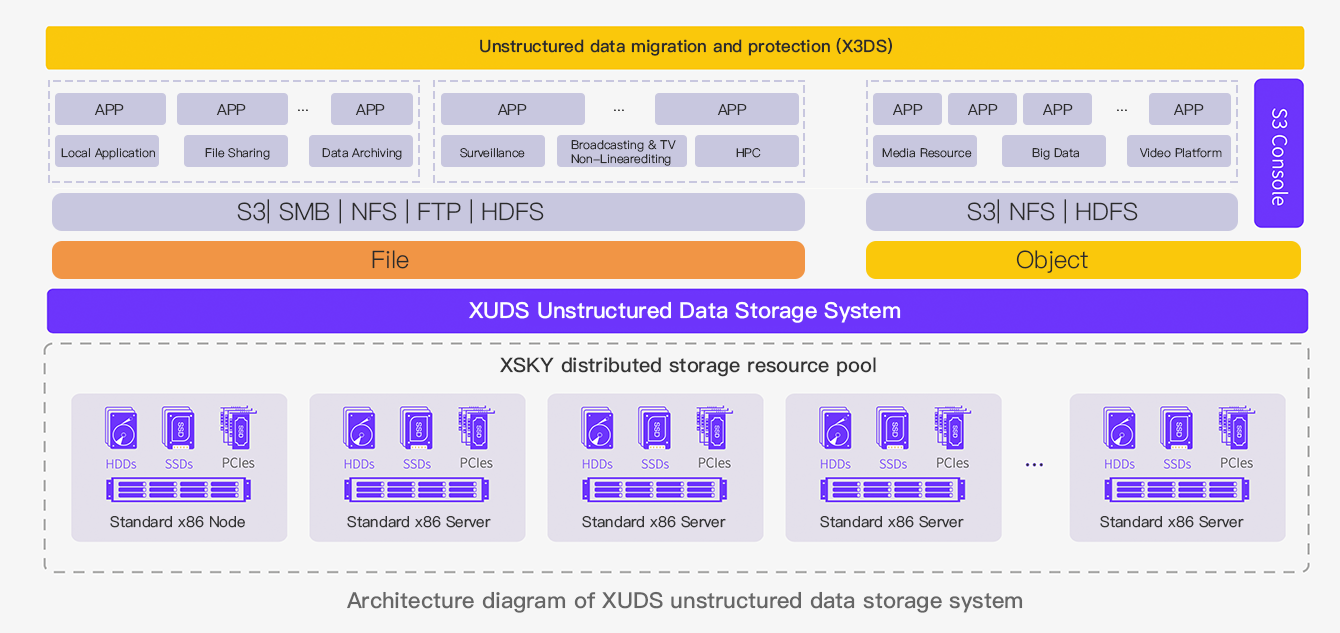User Needs
Enterprises need a complete unstructured data solution
The gradual popularization of IoT devices, increasing data analysis, and application cloudification have driven a massive increase in stored data. According to analysis, the global data volume will reach 180ZB in 2025. Although enterprises are aware of the huge value contained in data, and big data analysis has become a new engine for enterprise development, many data have not been activated or utilized, and a large amount of data value has been lost. According to IDC's "New Horizons in Data" report, only 32 percent of the data that businesses generate in their operations is utilized. Unstructured data contains a lot of information. Unstructured data accounts for 80% of the data generated by enterprises, and it is rapidly expanding at a compound annual growth rate of 60%. How to manage massive unstructured data and tap its value, It has become a problem that plagues enterprise data management.
Files and objects are two ways to organize unstructured data. Files adopt a hierarchical structure, which is more in line with human logic. Files can be frequently edited and modified, which is suitable for scenarios such as file sharing, video editing, and high-performance analysis. The object is a flat architecture, which is more machine-friendly and rarely modified. It is suitable for scenarios such as cloud-native applications, cloud resource pools, and content publishing. However, the scenarios of files and objects are not fixed. Most applications based on file storage can be converted to object storage after adaptation and transformation. In addition, for scenarios such as backup and archiving, big data analysis, etc., either the file method or the object method can be used. Therefore, enterprises also need cross-protocol data flow capabilities to manage unstructured data in a unified manner and arrange resources reasonably.

Product Value
Data flows freely, and XUDS meets diverse unstructured data storage and management needs:

XUDS (XSKY Unstructured Data System) is a one-stop unstructured data management platform created by XSKY. It adopts a software-defined architecture and supports POSIX, NFS, SMB/CIFS, FTP, S3, HDFS, CSI and other protocols, allowing Storage gets rid of the limitations of hardware and platforms, endows storage with flexible and agile features, and forms a carrying capacity for huge unstructured data. This carrying capacity is a solid foundation for realizing data assetization.
XUDS uses a distributed file system to provide file services, and can efficiently store and process 10 billion file-scale data through metadata clusters with high availability, strong consistency, and high scalability. It supports high-performance concurrent clients and is an ideal storage for HDPA scenarios. The object service adopts the object storage technology widely recognized by customers and has led the market for four consecutive years, and has rich enterprise-level features and data empowerment capabilities.
XUDS has a built-in X3DS three-dimensional data management system, which can provide three management capabilities of DR (Disaster Recovery), DP (Data Protection) and DM (Data Migration) for unstructured data. The three-dimensional (3D) data management platform realizes the mutual conversion and flow of files and objects, and conducts refined management and protection of data at the storage layer.

Product Advantages
Meet the different business needs of massive data
High-performance distributed file service and massive object service
- Rich protocol support: Support S3, NFS, CIFS/SMB, POSIX, FTP, HDFS, CSI and other protocols, and the data of files and objects can be converted to each other
- Provide 100-billion objects in a bucket storage service with unlimited expansion, continuous data online, cross-regional access, and intelligent hierarchical flow
- Support tens of billions of files that provide a global namespace, high performance, and full protocol interoperability
Flexible Expansion
- Software-defined, customizable node attributes, and support for general x86 servers of various brands
- Flexible deployment, can be expanded to thousands of nodes to meet different business needs
- The global unified namespace integrates multiple heterogeneous storage systems in different geographical locations on demand, realizes the storage of hundreds of billions of objects in a single bucket, and allows data to be read nearby
- On-demand expansion, file and storage services can be independently expanded, performance and capacity increase with the number of nodes, to meet the growing business performance and capacity needs
Continuous Protection
- EC, copy, and fault domain mechanisms to ensure the overall security of data in faults at the node level, cabinet level, and data center level
- Ensure enterprise data security and compliance requirements through technologies such as data encryption, multi-version, WORM, anti-leeching, fine-grained authority control, and log auditing
- It supports multi-active in the same city and remote master/backup reliability solutions to meet the disaster recovery needs of large-scale, cross-regional and multi-site data with strong consistency. Flexible configuration of inter-site data synchronization policies to deal with scenarios with different business data security levels
- Support file directory level snapshots and bucket snapshots, support manual snapshots and scheduled snapshots
- Hard disk and network sub-health processing, automatic identification of bad disks, slow disks and network faults, and automatic isolation
Complete unstructured data management functions
- Supports data replication function, RPO is at the minute level, and has a disaster recovery switching function. Support data verification to ensure the consistency of replicated data
- Support data migration function, support multi-directory concurrency, high performance
- Built-in data backup function, supports thousands of recovery points, RPO is hour level, supports deduplication and encryption
- Support data archiving function, rich archiving strategies, before deleting data, it will reconfirm that the data has been archived, which is more secure
- One-click jump to X3DS, supporting migration and disaster recovery of unstructured data




